Pietro Balatti
HRI2 Lab, Istituto Italiano di Tecnologia, Genoa, Italy
A Multipurpose Interface for Close- and Far-Proximity Control of Mobile Collaborative Robots
Jun 04, 2024



Abstract:This letter introduces an innovative visuo-haptic interface to control Mobile Collaborative Robots (MCR). Thanks to a passive detachable mechanism, the interface can be attached/detached from a robot, offering two control modes: local control (attached) and teleoperation (detached). These modes are integrated with a robot whole-body controller and presented in a unified close- and far-proximity control framework for MCR. The earlier introduction of the haptic component in this interface enabled users to execute intricate loco-manipulation tasks via admittance-type control, effectively decoupling task dynamics and enhancing human capabilities. In contrast, this ongoing work proposes a novel design that integrates a visual component. This design utilizes Visual-Inertial Odometry (VIO) for teleoperation, estimating the interface's pose through stereo cameras and an Inertial Measurement Unit (IMU). The estimated pose serves as the reference for the robot's end-effector in teleoperation mode. Hence, the interface offers complete flexibility and adaptability, enabling any user to operate an MCR seamlessly without needing expert knowledge. In this letter, we primarily focus on the new visual feature, and first present a performance evaluation of different VIO-based methods for teleoperation. Next, the interface's usability is analyzed in a home-care application and compared to an alternative designed by a commercial MoCap system. Results show comparable performance in terms of accuracy, completion time, and usability. Nevertheless, the proposed interface is low-cost, poses minimal wearability constraints, and can be used anywhere and anytime without needing external devices or additional equipment, offering a versatile and accessible solution for teleoperation.
Robot-Assisted Navigation for Visually Impaired through Adaptive Impedance and Path Planning
Oct 23, 2023



Abstract:This paper presents a framework to navigate visually impaired people through unfamiliar environments by means of a mobile manipulator. The Human-Robot system consists of three key components: a mobile base, a robotic arm, and the human subject who gets guided by the robotic arm via physically coupling their hand with the cobot's end-effector. These components, receiving a goal from the user, traverse a collision-free set of waypoints in a coordinated manner, while avoiding static and dynamic obstacles through an obstacle avoidance unit and a novel human guidance planner. With this aim, we also present a legs tracking algorithm that utilizes 2D LiDAR sensors integrated into the mobile base to monitor the human pose. Additionally, we introduce an adaptive pulling planner responsible for guiding the individual back to the intended path if they veer off course. This is achieved by establishing a target arm end-effector position and dynamically adjusting the impedance parameters in real-time through a impedance tuning unit. To validate the framework we present a set of experiments both in laboratory settings with 12 healthy blindfolded subjects and a proof-of-concept demonstration in a real-world scenario.
A Human Motion Compensation Framework for a Supernumerary Robotic Arm
Oct 16, 2023



Abstract:Supernumerary robotic arms (SRAs) can be used as the third arm to complement and augment the abilities of human users. The user carrying a SRA forms a connected kinodynamic chain, which can be viewed as a special class of floating-base robot systems. However, unlike general floating-base robot systems, human users are the bases of SRAs and they have their subjective behaviors/motions. This implies that human body motions can unintentionally affect the SRA's end-effector movements. To address this challenge, we propose a framework to compensate for the human whole-body motions that interfere with the SRA's end-effector trajectories. The SRA system in this study consists of a 6-degree-of-freedom lightweight arm and a wearable interface. The wearable interface allows users to adjust the installation position of the SRA to fit different body shapes. An inertial measurement unit (IMU)-based sensory interface can provide the body skeleton motion feedback of the human user in real time. By simplifying the floating-base kinematics model, we design an effective motion planner by reconstructing the Jacobian matrix of the SRA. Under the proposed framework, the performance of the reconstructed Jacobian method is assessed by comparing the results obtained with the classical nullspace-based method through two sets of experiments.
Pick the Right Co-Worker: Online Assessment of Cognitive Ergonomics in Human-Robot Collaborative Assembly
Jul 08, 2022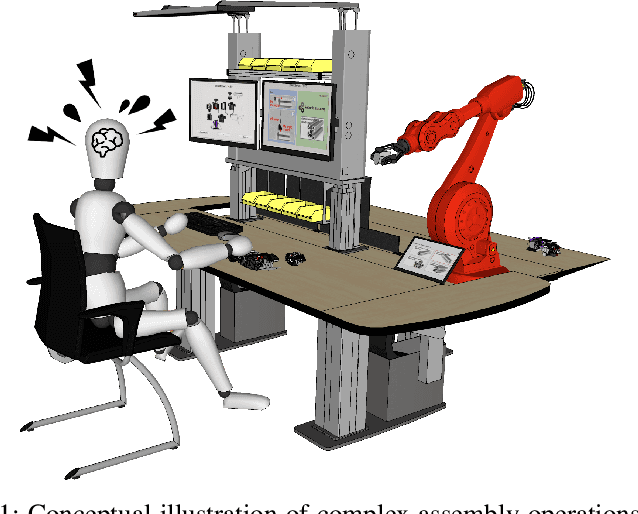
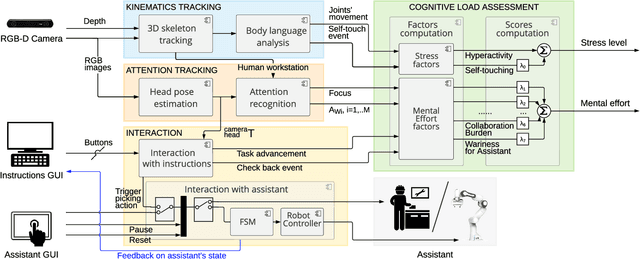

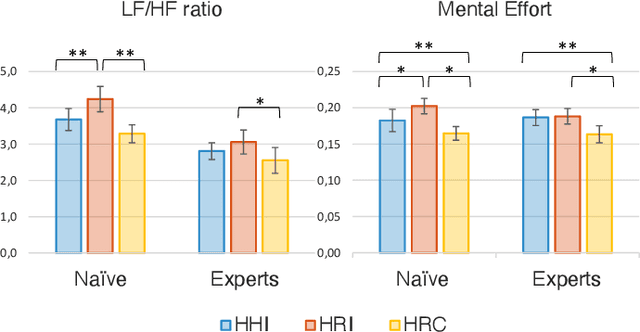
Abstract:Human-robot collaborative assembly systems enhance the efficiency and productivity of the workplace but may increase the workers' cognitive demand. This paper proposes an online and quantitative framework to assess the cognitive workload induced by the interaction with a co-worker, either a human operator or an industrial collaborative robot with different control strategies. The approach monitors the operator's attention distribution and upper-body kinematics benefiting from the input images of a low-cost stereo camera and cutting-edge artificial intelligence algorithms (i.e. head pose estimation and skeleton tracking). Three experimental scenarios with variations in workstation features and interaction modalities were designed to test the performance of our online method against state-of-the-art offline measurements. Results proved that our vision-based cognitive load assessment has the potential to be integrated into the new generation of collaborative robotic technologies. The latter would enable human cognitive state monitoring and robot control strategy adaptation for improving human comfort, ergonomics, and trust in automation.
A Self-Tuning Impedance-based Interaction Planner for Robotic Haptic Exploration
Mar 10, 2022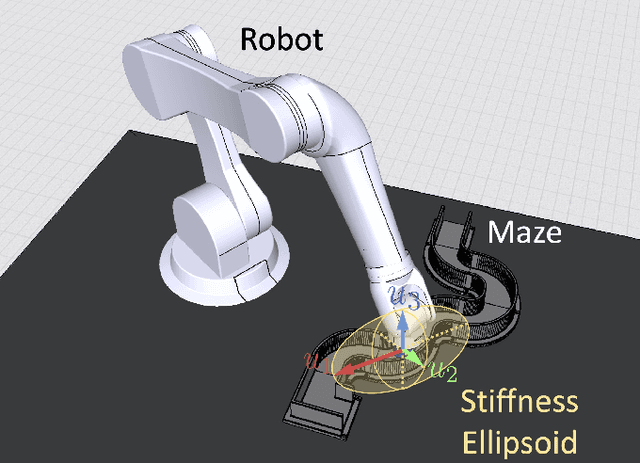
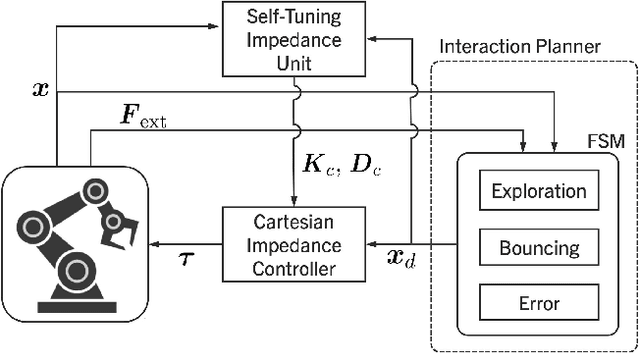
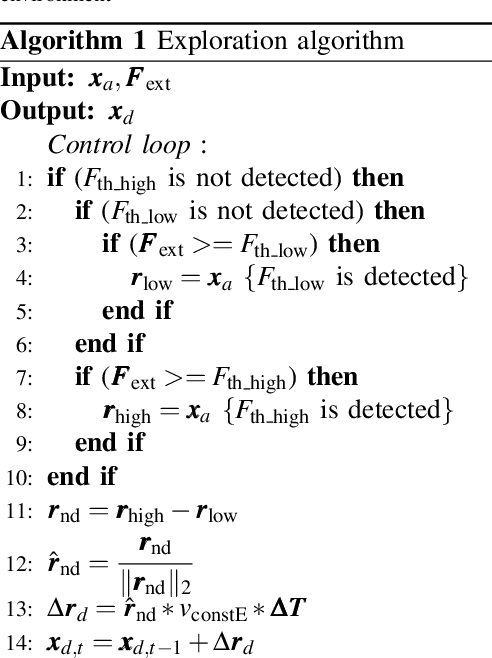
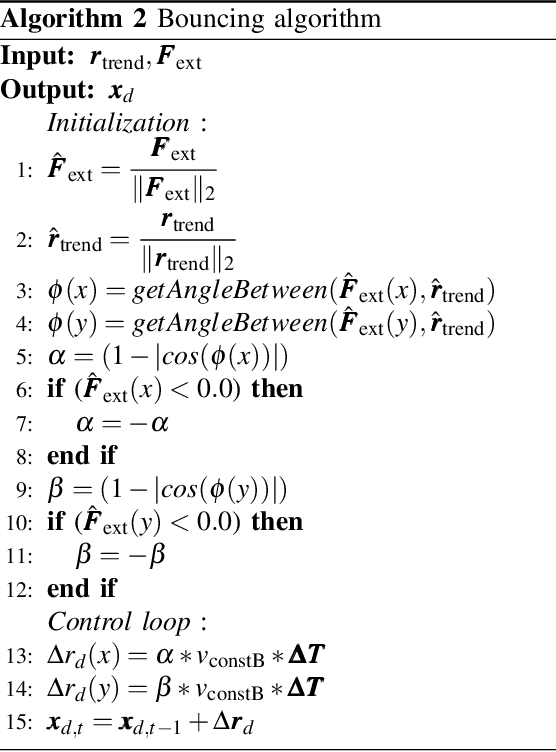
Abstract:This paper presents a novel interaction planning method that exploits impedance tuning techniques in response to environmental uncertainties and unpredictable conditions using haptic information only. The proposed algorithm plans the robot's trajectory based on the haptic interaction with the environment and adapts planning strategies as needed. Two approaches are considered: Exploration and Bouncing strategies. The Exploration strategy takes the actual motion of the robot into account in planning, while the Bouncing strategy exploits the forces and the motion vector of the robot. Moreover, self-tuning impedance is performed according to the planned trajectory to ensure stable contact and low contact forces. In order to show the performance of the proposed methodology, two experiments with a torque-controller robotic arm are carried out. The first considers a maze exploration without obstacles, whereas the second includes obstacles. The proposed method performance is analyzed and compared against previously proposed solutions in both cases. Experimental results demonstrate that: i) the robot can successfully plan its trajectory autonomously in the most feasible direction according to the interaction with the environment, and ii) a stable interaction with an unknown environment despite the uncertainties is achieved. Finally, a scalability demonstration is carried out to show the potential of the proposed method under multiple scenarios.
SUPER-MAN: SUPERnumerary Robotic Bodies for Physical Assistance in HuMAN-Robot Conjoined Actions
Jan 17, 2022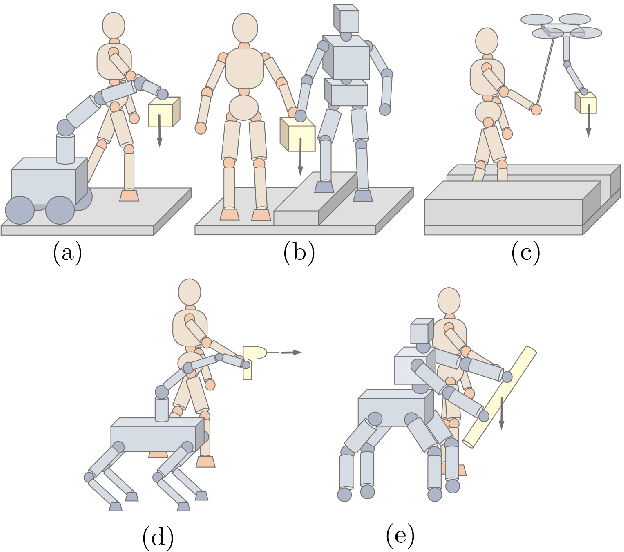



Abstract:This paper presents a mobile supernumerary robotic approach to physical assistance in human-robot conjoined actions. The study starts with the description of the SUPER-MAN concept. The idea is to develop and utilize mobile collaborative systems that can follow human loco-manipulation commands to perform industrial tasks through three main components: i) a physical interface, ii) a human-robot interaction controller and iii) a supernumerary robotic body. Next, we present two possible implementations within the framework - from theoretical and hardware perspectives. The first system is called MOCA-MAN, and is composed of a redundant torque-controlled robotic arm and an omni-directional mobile platform. The second one is called Kairos-MAN, formed by a high-payload 6-DoF velocity-controlled robotic arm and an omni-directional mobile platform. The systems share the same admittance interface, through which user wrenches are translated to loco-manipulation commands, generated by whole-body controllers of each system. Besides, a thorough user-study with multiple and cross-gender subjects is presented to reveal the quantitative performance of the two systems in effort demanding and dexterous tasks. Moreover, we provide qualitative results from the NASA-TLX questionnaire to demonstrate the SUPER-MAN approach's potential and its acceptability from the users' viewpoint.
A User-Centered Interface for Enhanced Conjoined Human-Robot Actions in Industrial Tasks
May 20, 2021
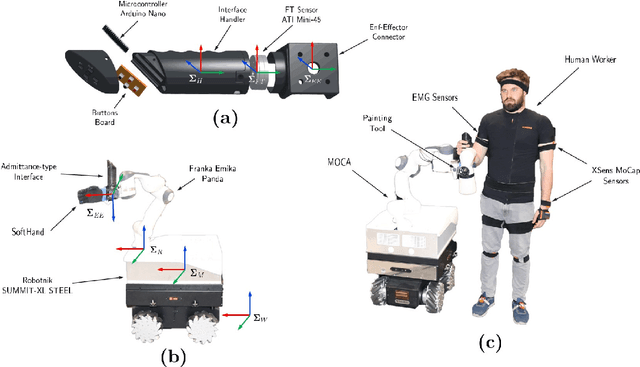


Abstract:This paper presents a user-centered physical interface for collaborative mobile manipulators in industrial manufacturing and logistics applications. The proposed work builds on our earlier MOCA-MAN interface, through which a mobile manipulator could be physically coupled to the operators to assist them in performing daily activities. The new interface instead presents the following additions: i) A simplistic, industrial-like design that allows the worker to couple/decouple easily and to operate mobile manipulators locally; ii) Enhanced loco-manipulation capabilities that do not compromise the worker mobility. Besides, an experimental evaluation with six human subjects is carried out to analyze the enhanced locomotion and flexibility of the proposed interface in terms of mobility constraint, usability, and physical load reduction.
 Add to Chrome
Add to Chrome Add to Firefox
Add to Firefox Add to Edge
Add to Edge